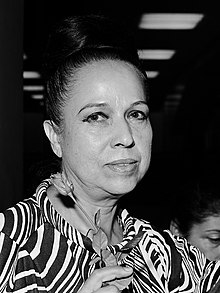Welcome to DU!
The truly grassroots left-of-center political community where regular people, not algorithms, drive the discussions and set the standards.
Join the community:
Create a free account
Support DU (and get rid of ads!):
Become a Star Member
Latest Breaking News
Editorials & Other Articles
General Discussion
The DU Lounge
All Forums
Issue Forums
Culture Forums
Alliance Forums
Region Forums
Support Forums
Help & Search
Women's Rights & Issues
Related: About this forumgoogle doodle for today honours Amalia Hernandez, dancer, founder Ballet Folklrico de Mxico
https://img.washingtonpost.com/wp-apps/imrs.php?src=
 &w=480
&w=480

Amalia Hernandez, the revolutionary Mexican dance pioneer, gets a Google Doodle salute
By Michael Cavna September 19 at 8:30 AM
(Google)
SOME DANCERS find their mastery by executing step after step in the studio. For Amalia Hernandez, the crucial pivot toward becoming a dance legend and cultural icon required countless steps to the far corners of her country. In such movement, she found her revolutionary muse. Today, on the centennial of her birth, Google celebrates Hernandez — the pioneering dancer and choreographer who founded Ballet Folklorico de Mexico — with the brilliant colors of movement in a home-page Doodle.
In the ’20s, young Amalia, who was born in Mexico City, received formal ballet training in the home, but although she had the discipline to devote herself to the art’s rigors, her sense of soulful expression was finding no home. Hernandez moved on to modern dance, which she taught at the Fine Arts National Institute, as well as Spanish flamenco. Yet for her, their formality did not yield deep artistic fertility.
Her journey to represent Mexican culture meant moving about her native nation, from coastlines to the mountain ridgelines. In the lands of her people, she pursued a creative excavation that fed her soul. Through travel, she found indigenous connection. Her inspired emotional ties led her to weave the fabric of Mexican folk dance with the tight threads of her formal training. The resulting artistic tapestry was her new dance style: baile folklorico.
In 1952, with just eight dancers, Hernandez founded the Ballet Folklorico de Mexico. Two years later, they kicked off their national TV broadcasts, which spawned North American tours that would begin to make Hernandez a cultural ambassador to the world. By the end of the decade, now on the path to international prominence, they would represent Mexico in the Pan American Games, and then at the Paris Festival of Nations in the next decade.
. . . .
https://www.washingtonpost.com/news/comic-riffs/wp/2017/09/19/amalia-hernandez-the-revolutionary-mexican-dance-pioneer-gets-a-google-doodle-salute/?utm_term=.4f9114c835f7
. . . .
Ballet Folklorico de Mexico
Hernández founded the dance company Ballet Folklórico de México in 1952, choosing to branch out with her experience and follow her own specific creative path. The group was small, consisting of only eight members in the beginning, and for their debut, Hernández presented the now-famous Melodies of Michoacan. In 1954, the chance to perform on television presented itself in the form of the Funcion de Gala program. This is when the momentum began to truly pick up, the group performing a new dance every weekly broadcast. Success was garnered, and Hernández not only became director; the group expanded to twenty members by the end of the 67 episode run. With that small amount of success came recognition, and Hernández’s company gained the attention of the department of tourism. The government endorsed her group, aiding her in touring North America in representation of Mexico, the results absolutely positive. By 1959, the group had grown to sixty members and was commissioned to participate in the Pan American Games in Chicago on behalf of Mexico.[5]
Being catapulted onto the national stage, Hernández and the company only worked harder, creating 40 different dances in the 1960s alone. Following from there, her prominence as a cultural icon was only cemented further, as she went to choreograph about 70 dances, with performances around the world. In fact, the company has “performed more than 15,000 times for a total audience number of more than 22 million people”, one of those performances being for John F. Kennedy during his presidency.[5]
Cultural significance
Hernández was always vocal about her love for her native Mexico, but she was careful to place significance upon Mesoamerican cultures, highlighting them when possible through her dancing. Her goal was to convey the diversity of Mexico, while also exploring pre-Columbian culture and traditions. She became a symbol for Mexicanidad, her pursuit of indigenous inclusionary dance an indication of her dedication to the presentation of a realistic Mexican identity (i.e. not only Western-influenced).
Hernández’s love of indigeneity has also cemented the indigenous image of Mexico around the world, a direct result of the company’s world-wide presence. This has helped recognize the unique Mexican culture, as well as promote a sense of national pride in regards to folklorico dancing. Additionally, she did did not shy away from regional differences, her dances focusing on specific geographical areas and cultural areas in Mexico in order to provide a diverse outlook of Mexico. For example, her most famous dances (Melodies of Michoacan, Deer Dance, Jalisco, Fandangos) all spotlight certain areas of Mexico, along with their cultural traditions.[6]
. . . .
https://en.wikipedia.org/wiki/Amalia_Hern%C3%A1ndez
InfoView thread info, including edit history
TrashPut this thread in your Trash Can (My DU » Trash Can)
BookmarkAdd this thread to your Bookmarks (My DU » Bookmarks)
0 replies, 1595 views
ShareGet links to this post and/or share on social media
AlertAlert this post for a rule violation
PowersThere are no powers you can use on this post
EditCannot edit other people's posts
ReplyReply to this post
EditCannot edit other people's posts
Rec (4)
ReplyReply to this post